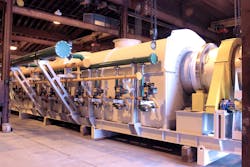Using rotary kilns for high-temperature bulk solids processing
Rotary kilns are used extensively throughout the industrial processing sector, helping companies deliver on product quality, process efficiency, and resource extraction. The rotary kiln’s diverse capabilities have made it a cornerstone of modern industry, and as pressure to build a circular economy intensifies, the reach of this thermal processing device is ever-growing. The following explains how rotary kilns are leveraged in industry, how these machines work and the various configurations and customizations that make them so adaptable.
How rotary kilns are used
The basic premise of a rotary kiln is simple: use heat to cause a chemical reaction or physical change in a material. While this principle is straightforward, it can be applied in a nearly unimaginable number of ways. As such, rotary kilns are used in every industry, from mining to chemical manufacturing. Further, kiln use continues to grow as industries look to improve efficiency and develop new processes around recovering wastes and reusing process byproducts.
Some of the most common ways in which rotary kilns are leveraged in today’s economy include the following:
Carbon products. Numerous carbon products are produced using rotary kilns, particularly as more sustainable avenues are sought for recovering value from forest product wastes and residuals.
Both biochar and activated carbon can be produced from organic cellulosic feeds such as manure, crop residues, coconut husks and more. Many of these applications are still nascent, using small-scale equipment as the market develops, but rotary kilns look to be the preferred device in producing these materials at commercial scale. Many mature activated carbon products are already produced and reactivated using rotary kilns.
Rotary kilns are also increasingly being used to recover carbon black from waste tires via pyrolysis.
Catalyst production and recovery. Catalysts are an essential component in modern industry, and their use is constantly on the rise as technologies advance and producers look to improve the efficiency of chemical reactions. The rotary kiln is the preferred device for producing catalyst substrates, impregnating carriers with the catalyst component and recovering spent catalysts for reuse.
Recovery of valuable components & metals from waste. One of the most important rising applications for rotary kilns is the recovery of valuable components or metals from various wastes and process byproducts. Historically, these materials have been landfilled or stored in tailings facilities because they are often toxic, caustic or simply unusable in their existing form. By processing them in a rotary kiln, producers can recover valuable components, often rendering the resulting waste inert and significantly reduced in volume.
As a result, rotary kilns have become an essential tool in circular economy efforts, recovering materials such as:
- Copper, nickel and other metals from e-waste
- Iron, aluminum and other metals from red mud (bauxite tailings)
- Cobalt, vanadium and other metals from spent catalysts
- Alumina, gold and other metals from fly ash.
Production of advanced mineral products. Rotary kilns are used extensively in the production of mineral products such as roofing granules, adsorbents, fillers, desiccants, molecular sieves and more. In these settings, rotary kilns help to remove impurities, modify physical and chemical properties, bond coatings and colors to base materials and more.
Plastics-to-fuel (PTF) technology. PTF technology is becoming an increasingly important way of managing plastic wastes. Rotary kilns are used to carry out pyrolysis, allowing a wider range of plastic waste types to be recycled — a much-needed alternative for plastics that cannot be processed through traditional mechanical approaches. This process ultimately converts plastics into fuel or the building blocks of petroleum products.
Waste incineration. The incineration of waste has been on the rise in the waste management sector as a way to effectively get rid of hazardous materials while generating energy and reducing the volume of wastes. The practice has been a vital tool in recent times, helping to manage the surge in wastes coming from the medical community as a result of the pandemic. Rotary kilns are the preferred device in these settings because, as with plastic, they can process an extensive scope of waste types all at once.
How rotary kilns work
Rotary kilns rely on rotary drum technology to process materials. Material is tumbled in a rotating drum, which is heated either internally (direct heating) or externally (indirect heating) to heat the material to the desired temperature and cause the intended reaction. The temperature(s) at which the material is processed, as well as the retention time (how long the material is processed) are predetermined based on a thorough chemical and thermal analysis. The rotating drum is sealed to the stationary breeching at each end to control the atmosphere and temperature inside the kiln to manage the reaction(s).
Operating at temperatures ranging from 800 to 2,200°F, rotary kilns, sometimes referred to as calciners, are widely used to carry out several basic thermal processes, including:
- Calcination
- Incineration
- Thermal desorption
- Organic combustion
- Heat setting.
Direct rotary kilns. Of the two configurations, direct rotary kilns are by far the most efficient due to the direct heat transfer between the material and heating medium. Direct kilns can process material at temperatures between 800 and 2,372°F (430-1,300°C).
In a direct kiln, process gas passes through the drum either co-currently (in the same direction) or counter-currently (in the opposite direction) to the material. The drum is typically refractory lined but may contain lifting or tumbling flights for specific processes to improve heat transfer between the material and process gas by encouraging bed turnover or creating a showering effect of the material through the process gas.
A combustion chamber may or may not be used depending on the material’s sensitivity to heat.
A refractory lining is common in direct-fired kilns, as it protects the drum shell from the temperatures within, while also acting as an insulator to promote better heat retention.
Indirect rotary kilns. Indirect rotary kilns are less efficient than their direct counterparts but are essential in cases where a fine particle size would otherwise risk particle entrainment in the process gas, or when the material being processed requires a special processing atmosphere, such as one devoid of oxygen. Indirect kilns can process material at temperatures between 800-1,832°F (430-1,000°C).
In the case of an indirect kiln, the rotating drum is sealed off from the surrounding environment and heated externally by a furnace or heat shroud. External heating is facilitated by electricity or natural gas, which allows for the creation of tightly controlled temperature zones along the length of the kiln.
The material being processed is heated through contact with the drum shell as the material bed tumbles. Tumbling flights are typically incorporated to optimize agitation and bed turning for uniform heating of the material.
A purge gas may be incorporated through an inlet port, with an accompanying outlet port for purge gas exhaust.
Because indirect kilns keep the material and products of combustion separate, they can use a smaller exhaust gas handling system.
Supporting equipment
Rotary kilns require a variety of support components to operate properly, safely, and within regulation. Key supporting equipment is summarized here:
Burner. In direct-fired systems, the burner is the source of combustion. Operating off a fuel source, along with combustion and dilution air, the burner provides the required process heat. Burners can operate from a variety of fuel sources, with natural gas, propane and diesel being the most common. Various burner designs and configurations are available to meet production and efficiency requirements.
Exhaust gas handling system. Exhaust gas handling systems are essential in both direct and indirect kilns, treating any off gases so they meet emissions requirements and can be safely released into the atmosphere. Exhaust gas handling systems can vary significantly depending on the material being processed, any co-products yielded, whether the kiln is direct or indirect, the gas volume and many other factors. Typical equipment includes thermal oxidizers/secondary combustion chambers, quench towers, venturi scrubbers, packed towers, evaporative coolers, baghouses, wet electrostatic precipitators, waste heat recovery boilers and more.
Controls. Control systems are constantly advancing in terms of the data they can collect and the level of automation they can achieve. Systems range significantly from the most basic, automating startup and shutdown, to highly advanced, trending and reporting on data for predictive maintenance, custom alerts, and upset intervention.
Advantages of rotary kilns
Rotary kilns offer several benefits in a bulk solids processing setting, providing the foundation for their continued selection. Among the most recognized benefits are:
Opportunity for customization. Rotary kilns offer incredible opportunity for customization in every aspect of design. From drum length and diameter to internals and additional components, rotary kilns can be engineered to suit nearly any application down to the smallest detail for optimal, efficient processing. This flexibility is in part what has led to their ubiquitous use.
High throughput. Another key reason rotary kilns are chosen is their high capacity. A direct-fired kiln can process anywhere from 1 to 25 tph (0.5 to 22 metric tph) of material, while indirect-fired kilns can process between 200 lb/h to 20 tph, making them an ideal option for high-capacity settings such as mineral processing and the production of roofing granules.
Heavy-duty construction. Like other rotary drum-based technologies, rotary kilns are typically engineered and constructed for especially demanding applications. From corrosive or abrasive materials to harsh processing environments and 24/7 operation, rotary kilns are built for reliability in the toughest settings.
Acceptance of a wide variation in feedstock. Another major reason for the use of rotary kilns in any given application is their ability to uniformly process a wide array of feedstock sources simultaneously. This has been demonstrated in the plastics and medical industries and has opened the door to new opportunities in waste management.
Simple operation and adoption. Rotary drum technology is employed in nearly every industry imaginable. With simple operating principles, the machines require minimal operator training and supervision. In many cases, operators are already familiar with how the machines work because of their extensive use in other settings, making adoption simple and straightforward.
Longevity. The rotary kiln’s simple mechanics, combined with its robust build equates not only to a reliable system, but also to a system that will stand the test of time. When properly maintained, rotary kilns can provide decades of consistent processing.
Determining whether a rotary kiln is a good fit
Rotary kilns are not a good fit for all applications. When processing some low-solids materials, for example, an alternative technology may be more suitable. Low-capacity needs are also generally better met through alternative technologies.
Whether a rotary kiln is a fit for a given application is not always readily apparent, particularly as new applications continue to be explored. In such cases, testing in a facility such as The FEECO Innovation Center can offer critical insight into whether the intended process is feasible and whether a rotary kiln will be suitable. Testing also reveals any requirements for material pretreatment, such as crushing or grinding, drying or agglomeration (pelletizing).
The Innovation Center offers both batch- and pilot-scale kilns for testing feasibility, as well as continuous process development and the gathering of data for commercial scale-production and equipment design.
Alternatively, producers can rent batch-scale kilns for initial internal feasibility testing as well as research and development.
Conclusion
The flexible design and processing capabilities of rotary kilns has made them a key tool in modern industry. As technologies advance and industries look for ways to implement a circular economy approach, the role of these thermal processing devices will only gain importance. However, the increasing number of applications using rotary kilns, combined with their potential for customization, makes thorough testing and process development work essential in engineering an optimized system.
Alex Ebben is a process sales engineer at FEECO International specializing in high-temperature thermal processing applications, including both equipment design and process development.
Carrie Carlson is a technical writer who has been with FEECO for over a decade. She works closely with engineers and process experts to turn complex ideas into easy-to-understand literature.
FEECO International








